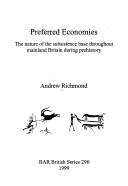| Listing 1 - 4 of 4 |
Sort by
|
Book
ISBN: 1803271531 1803271523 Year: 2022 Publisher: Oxford : Archaeopress Publishing Ltd,
Abstract | Keywords | Export | Availability | Bookmark
 Loading...
Loading...Choose an application
- Reference Manager
- EndNote
- RefWorks (Direct export to RefWorks)
Waterlands: Prehistoric Life at Bar Pasture, Pode Hole Quarry, Peterborough recounts a decade-long archaeological investigation at Bar Pasture Farm, Pode Hole Quarry, Peterborough, and represents one of the most significant landscape excavations carried out in recent years. The 55-hectare archaeological dig was the scene of human activity on the fenland edge from the Mesolithic through to the Late Iron Age, although the majority of the evidence covered the period from the Early Neolithic through to the Middle Bronze Age. Throughout prehistory, the fen edge has represented a landscape at the margins of human habitation and exploitation. During the Early Neolithic, a substantial waterhole complex with signs of later visitation was established on the fen edge. Traces of several Beaker buildings provided elusive evidence of slightly later activity further inland, whilst during the Early Bronze Age proper, a number of impressive burial mounds were constructed within a dedicated 'Barrow Field'. One barrow contained the nationally significant remains of an infant burial on a birch bark mat with associated grave goods. The Middle Bronze Age saw the entire re-organisation of the surrounding landscape by the creation of an extensive, rectilinear field system, served by multiple droveways and associated with a classic enclosed farmstead. The placement of later Middle Bronze Age cremation burials within the remains of earlier burial monuments bears witness to the intimate connection of this small community to their ancestors' sacred landscape. By the 4th century BC, settlement was all but abandoned due to marine inundations, although one slightly elevated part of the landscape formed an area of refuge for an Iron Age smith and his family, who created an isolated and significant smithy.
Excavations (Archaeology) --- Archaeological digs --- Archaeological excavations --- Digs (Archaeology) --- Excavation sites (Archaeology) --- Ruins --- Sites, Excavation (Archaeology) --- Archaeology

ISBN: 1841710334 Year: 1999 Publisher: Oxford : Archaeopress,
Abstract | Keywords | Export | Availability | Bookmark
 Loading...
Loading...Choose an application
- Reference Manager
- EndNote
- RefWorks (Direct export to RefWorks)
Book
ISBN: 1108917453 1108912516 1108913091 1108831494 Year: 2021 Publisher: Cambridge : Cambridge University Press,
Abstract | Keywords | Export | Availability | Bookmark
 Loading...
Loading...Choose an application
- Reference Manager
- EndNote
- RefWorks (Direct export to RefWorks)
Our current ecological crises compel us not only to understand how contemporary media shapes our conceptions of human relationships with the environment, but also to examine the historical genealogies of such perspectives. Written during the onset of the Little Ice Age in Britain, Middle English romances provide a fascinating window into the worldviews of popular vernacular literature (and its audiences) at the close of the Middle Ages. Andrew M. Richmond shows how literary conventions of romances shaped and were in turn influenced by contemporary perspectives on the natural world. These popular texts also reveal widespread concern regarding the damaging effects of human actions and climate change. The natural world was a constant presence in the writing, thoughts, and lives of the audiences and authors of medieval English romance - and these close readings reveal that our environmental concerns go back further in our history and culture than we think.
Romances, English --- Seashore in literature. --- Landscapes in literature. --- English literature --- History and criticism. --- Landscape in literature
Book
ISBN: 9781108831499 9781108917452 9781108926669 Year: 2021 Publisher: Cambridge, United Kingdom ; New York, NY : Cambridge University Press,
Abstract | Keywords | Export | Availability | Bookmark
 Loading...
Loading...Choose an application
- Reference Manager
- EndNote
- RefWorks (Direct export to RefWorks)
"In Sir Isumbras, one of the most enduringly popular late medieval romances, the penitential experience of its eponymous hero (modeled off of the evergreen St. Eustace tales) is grounded in a careful exploration of hillside ironmines and the communities of smiths that rely upon them. Such an interest in natural resource management and industrial development derives from the notable focus on charting topography that distinguishes the central third of the romance - marking Isumbras's transition from secular to divine systems of values, and his geographical movement from Christian to Saracen lands. Similarly, in the fourteenth-century Middle English version of William of Palerne (hereafter William), the eponymous protagonist flees with his lover, Melior, through a world of forests and bays that overflows with topographical details. I will also consider how sympathetic portrayals of laborers and other low-class harvesters of natural resources suggest that romances, particularly around the turn of the fifteenth century, reflect the shifting nature of their bourgeois-gentry audience by engaging with the environmental experiences of merchants, household clerks, reeves, franklins, and gentry farmers in addition to those of the higher aristocracy"-- These intricate explanations of quarry pits, hollow oaks, roadside groves, seaside caves, and war-torn estates together compose a perspective on landscape defined by networks of economic exchange. In this regard, the predominant view of the natural world presented in William ties it to earlier romances such as Havelok the Dane, a text interested in the systems of exchange that knit seaside fishermen to urban markets; and to later texts such as the Middle English versions of Partonope of Blois, which demonstrates in its depictions of estates the mercantile and agricultural uses of natural spaces that underlie the successful maintenance of a noble identity. This chapter, then, will discuss how Middle English romances' attention to the management and harvest of natural resources often reveals the link between country and urban spaces created by the exchange of such goods.
English literature --- Landscapes in literature. --- Romances, English --- Romances, English. --- Seashore in literature. --- History and criticism --- Middle English. --- History and criticism. --- 1100-1500.
| Listing 1 - 4 of 4 |
Sort by
|

 Search
Search Feedback
Feedback About
About Help
Help News
News